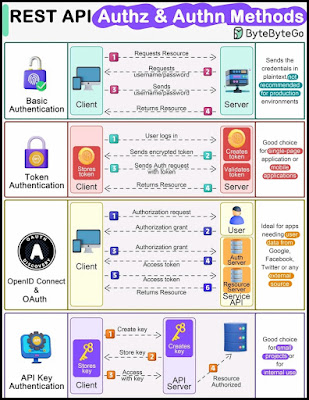Secure Connections: API Access Control
It is important to make sure that only approved users and applications can access or make changes to resources in our API.
Here are some common ways to secure REST APIs:
1. 𝗕𝗮𝘀𝗶𝗰 𝗔𝘂𝘁𝗵𝗲𝗻𝘁𝗶𝗰𝗮𝘁𝗶𝗼𝗻
This sends a username and password with each request to the API. It’s straightforward, but not very secure unless used with encryption like HTTPS.
Good for simpler apps where advanced security is not critical. Should be combined with encrypted connections.
2. 𝗧𝗼𝗸𝗲𝗻 𝗔𝘂𝘁𝗵𝗲𝗻𝘁𝗶𝗰𝗮𝘁𝗶𝗼𝗻
This uses tokens, like JSON Web Tokens (JWT), that are exchanged between the client app and server. Login information is not sent with each request.
Better for more secure and scalable apps where not sending credentials each time is essential.
3. 𝗢𝗽𝗲𝗻𝗜𝗗 𝗖𝗼𝗻𝗻𝗲𝗰𝘁 𝗮𝗻𝗱 𝗢𝗔𝘂𝘁𝗵
These allow limited third-party access to user data without exposing passwords. OpenID Connect handles user authentication and OAuth handles authorization.
Perfect when third-party services need controlled access to user data, like when integrating with Google, Facebook, or Twitter.
4. 𝗔𝗣𝗜 𝗞𝗲𝘆 𝗔𝘂𝘁𝗵𝗲𝗻𝘁𝗶𝗰𝗮𝘁𝗶𝗼𝗻
This gives unique keys to users or apps which are sent in request headers or query parameters. Simple to implement but may not be as robust as token or OAuth methods.
Good for basic access control when security needs are moderate. Allows access to specific API functionalities without complex user permissions.
Securing our API should be a top concern. The method chosen should match the sensitivity of the data and the required protection level.

